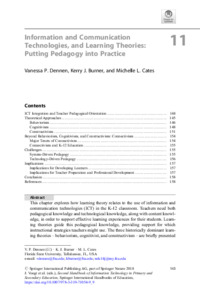Information and Communication Technologies, and Learning TheoriesPutting Pedagogy into Practice
Vanessa P. Dennen, Kerry J. Burner, Michelle L. Cates
Zu finden in: Second Handbook of Information Technology in Primary and Secondary Education (Seite 143 bis 160), 2018
  |
 |
 Diese Seite wurde seit 3 Jahren inhaltlich nicht mehr aktualisiert.
Unter Umständen ist sie nicht mehr aktuell.
Diese Seite wurde seit 3 Jahren inhaltlich nicht mehr aktualisiert.
Unter Umständen ist sie nicht mehr aktuell.
 Zusammenfassungen
Zusammenfassungen
 This chapter explores how learning theory relates to the use of information and communication technologies (ICT) in the K-12 classroom. Teachers need both pedagogical knowledge and technological knowledge, along with content knowledge, in order to support effective learning experiences for their students. Learning theories guide this pedagogical knowledge, providing support for which instructional strategies teachers might use. The three historically dominant learning theories – behaviorism, cognitivist, and constructivism – are briefly presented through vignettes that explore student and teacher ICT use. Basic tenets of each theory are briefly discussed along with examples of instructional strategies that reflect each theoretical approach to ICT use. A fourth theory, connectivism, which has yet to be fully accepted or embraced as a major learning theory but nonetheless represents a theoretical approach to learning via ICT-based networks, also is explored. With these theories in mind, this chapter notes that ICT are not always used in a manner that reflects sound or thoughtful pedagogical decisions; a teacher’s pedagogical choices may also be system-driven or technology-driven. As the chapter concludes, we share implications both for using ICT in a manner that is consistent with and fully supports learner development and for supporting teacher development of knowledge about learning theory along with the intersection of pedagogy and technology.
This chapter explores how learning theory relates to the use of information and communication technologies (ICT) in the K-12 classroom. Teachers need both pedagogical knowledge and technological knowledge, along with content knowledge, in order to support effective learning experiences for their students. Learning theories guide this pedagogical knowledge, providing support for which instructional strategies teachers might use. The three historically dominant learning theories – behaviorism, cognitivist, and constructivism – are briefly presented through vignettes that explore student and teacher ICT use. Basic tenets of each theory are briefly discussed along with examples of instructional strategies that reflect each theoretical approach to ICT use. A fourth theory, connectivism, which has yet to be fully accepted or embraced as a major learning theory but nonetheless represents a theoretical approach to learning via ICT-based networks, also is explored. With these theories in mind, this chapter notes that ICT are not always used in a manner that reflects sound or thoughtful pedagogical decisions; a teacher’s pedagogical choices may also be system-driven or technology-driven. As the chapter concludes, we share implications both for using ICT in a manner that is consistent with and fully supports learner development and for supporting teacher development of knowledge about learning theory along with the intersection of pedagogy and technology. Dieses Kapitel erwähnt ...
Dieses Kapitel erwähnt ...
 Personen KB IB clear | John Ainley , Julian Fraillon , Tim Friedman , Eveline Gebhardt , Wolfram Schulz | |||||||||||||||||||||||||||
 Begriffe KB IB clear | Content KnowledgeContent Knowledge , Pedagogical KnowledgePedagogical Knowledge , Zone of Proximal Development | |||||||||||||||||||||||||||
 Bücher |
|
 Dieses Kapitel erwähnt vermutlich nicht ...
Dieses Kapitel erwähnt vermutlich nicht ... 
 Tagcloud
Tagcloud
 Zitationsgraph
Zitationsgraph
 Zitationsgraph (Beta-Test mit vis.js)
Zitationsgraph (Beta-Test mit vis.js)
 Anderswo finden
Anderswo finden
 Volltext dieses Dokuments
Volltext dieses Dokuments
 |  Information and Communication Technologies, and Learning Theories: Putting Pedagogy into Practice: Artikel als Volltext bei Springerlink ( Information and Communication Technologies, and Learning Theories: Putting Pedagogy into Practice: Artikel als Volltext bei Springerlink ( : :  , 285 kByte; , 285 kByte;  : :  ) ) |
 Anderswo suchen
Anderswo suchen 
 Beat und dieses Kapitel
Beat und dieses Kapitel
Beat hat Dieses Kapitel während seiner Zeit am Institut für Medien und Schule (IMS) ins Biblionetz aufgenommen. Beat besitzt kein physisches, aber ein digitales Exemplar. Eine digitale Version ist auf dem Internet verfügbar (s.o.). Aufgrund der wenigen Einträge im Biblionetz scheint er es nicht wirklich gelesen zu haben. Es gibt bisher auch nur wenige Objekte im Biblionetz, die dieses Werk zitieren.










 Biblionetz-History
Biblionetz-History